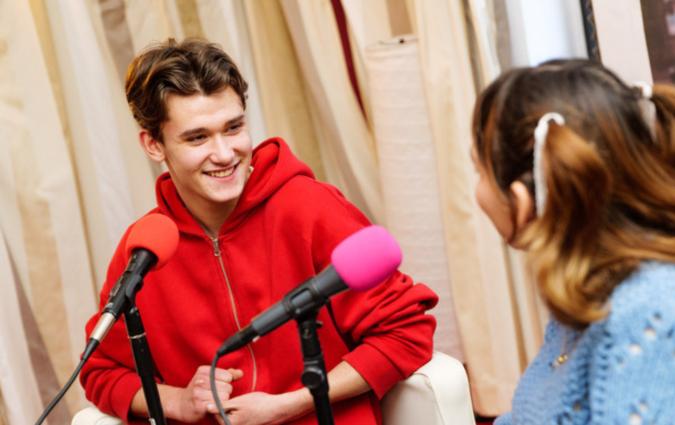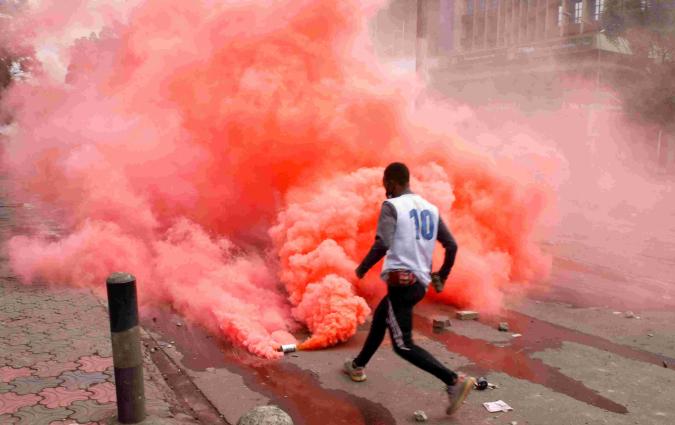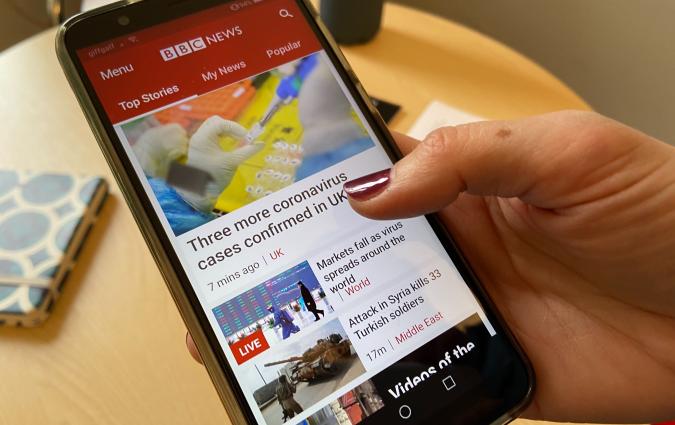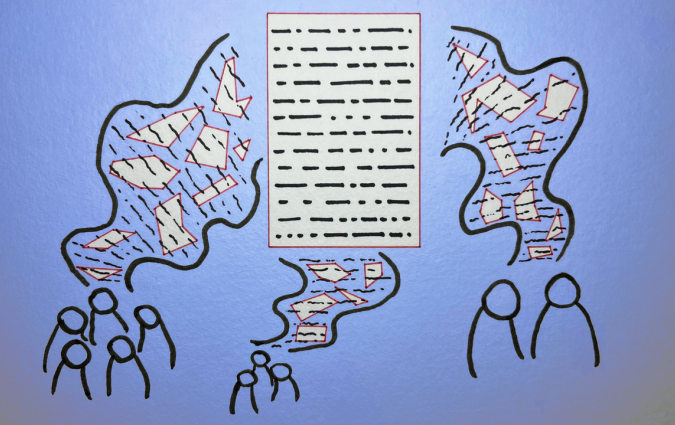How this Indonesian news outlet gets ‘terminally online’ Gen-Z to care about politics
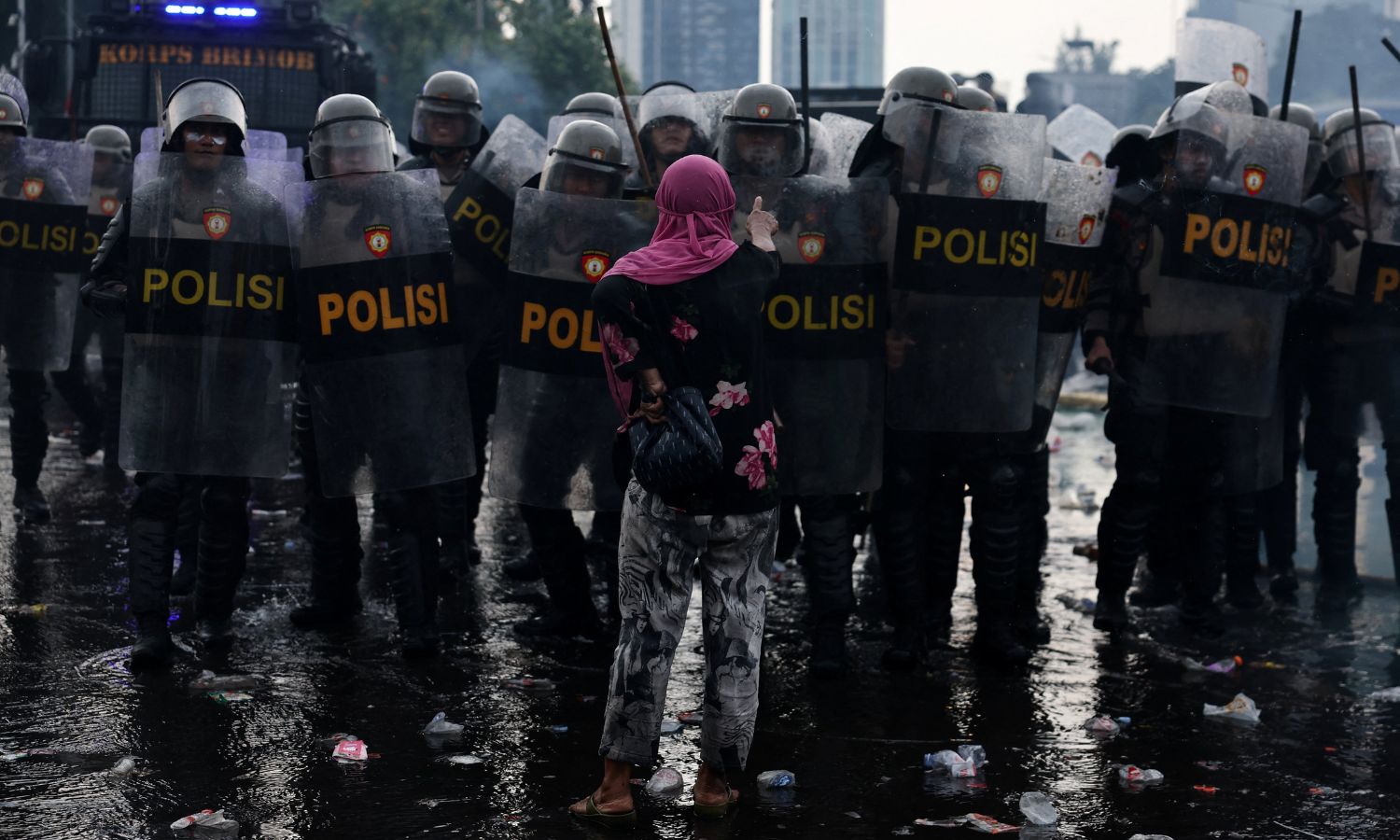
A woman confronts riot police during clash at a protest outside Indonesian parliament buildings, in Jakarta, Indonesia, August 28, 2025. REUTERS/Willy Kurniawan
A wave of protests swept across Indonesian cities in August, with thousands of demonstrators focusing their anger on government austerity measures, the high cost of living and steep housing allowances for legislators.
The death of a delivery driver run over by security forces amid the protests only led to an intensification of the unrest, which swiftly became the biggest Indonesian protest movement in decades. Seven people were killed, hundreds were injured, and government buildings and police headquarters were ransacked.
As I followed the protests from afar, I saw members of my family and friends in Indonesia sharing Instagram updates from a social-first news outlet, ‘What Is Up, Indonesia?’
“She’s so cool,” is how my cousin’s son labelled an Instagram story featuring Abigail Limuria, co-founder of the outlet. In the video, Limuria explains the unfolding protests to Al Jazeera. The clip has well over 22 million views.
‘What Is Up, Indonesia?’ or WIUI (pronounced “wee-wee”), is part of a new wave of irreverent news accounts primarily harnessing social media to reach young people. More than 40% of Indonesia’s population is under 25, making Gen-Z a huge potential news audience. Majorities of those aged 18 to 24 use TikTok, Instagram and YouTube. Well over a third use Instagram (36%) and TikTok (40%) for news in particular. But WIUI caters specifically to a subset who are comfortable with English.
Their website makes the disclaimer that it is “still not an official news site” as it is not yet a licensed news company. Editor-in-chief Dzaky Putra told me WIUI has 14 contributors who are “literally just a bunch of kids getting together on social media,” whose ages range from 20 to 30. Nevertheless, the outlet has grown rapidly, reaching well over 400,000 followers on Instagram through its informal tone of voice, memes, and a sense of authenticity and connection with its journalists, some of whom have become stars in their own right.
WIUI makes an effort to build community amongst its followers, or “Wuiboos”, as they are affectionately called, through the messaging platform Discord and ‘super casual and introvert-friendly’ in-person events. This playful relationship with its audience sees it even trolling its own website visitors; click on some of the links that promise something interesting and you’re Rickrolled.
Despite this relaxed tone, WIUI exists to explain – or, as they say, “spoonfeed” – political news to those who have been alienated from it. Lifestyle content rarely features. For its YouTube podcast, they have recently interviewed two former governors of Jakarta, as well as a host of comedians, business leaders, historians and cultural figures.
But Instagram is where most of its news and explainers live. Here, you will find a straight-to-camera piece explaining why the One Piece flag became a symbol of resistance for some Indonesians, an animated graphic outlining the protest movement’s specific demands for accountability in the wake of the unrest, and several collaborative posts with Indonesian diaspora groups worldwide. The videos regularly surpass one million views.
I spoke to Putra, WIUI’s editor-in-chief, who has been in position for just over a year, during which time the outlet’s followers have more than doubled. He discussed the outlet’s mission, how the team is engaging with its young followers, and how mainstream news media have responded. Our conversation has been edited for length and clarity.
Q. How does WIUI fit into the overall Indonesian media landscape?
A. In 2020, our co-founders saw that there was a gap between more cosmopolitan younger Indonesians and the mainstream media. These young people are very international, have lived abroad for some time, or are in certain social circles in Jakarta. A lot of them are very Anglo-centric, and they are a pretty big population and growing.
Now, we are informing a typically apathetic segment of the population. If you're Anglo-centric in Indonesia, it means you are pretty privileged. And often, privilege equals apathy. We are attempting to rope in these privileged kids, as well as the diaspora kids, and let them know what’s what. This includes myself. I grew up knowing diddly squat about what was going on back home. Kids like me are our target audience.
Q. Is catering to an elite audience a problem, or is it just an audience segment who you think need reaching?
A. I think it’s more the latter. I think they do need to be reached, and if it so happens that they are socioeconomically privileged, we just happen to be able to reach these people. I personally have met people who aren’t as well-to-do, but are also avid readers, even part of our Discord community. It’s just that they are what you call ‘permanently online’, and also very Anglo-centric, not because they grew up abroad, but because they don’t leave their house very often.
So it’s a pretty broad spectrum. We’re really for anyone who needs this sort of primer, because we don’t see ourselves as a news site. We condense things into bite-sized articles and make it simple for people to understand, lowering the barrier of entry.
Q. What are the main channels that you focus on?
A. Our main channel is Instagram, even though we do have a presence on TikTok and Twitter [X], but we tend to focus more on Instagram. Our target demographics are very Instagram-oriented, whereas TikTok is a bit of a minefield, because sometimes we attract unwanted attention from “Buzzers”. These are essentially human-run bot farms that churn out talking points that basically muddy the water around political discourse.
Q. And can you talk a bit about how you focus on building community? I saw that your Discord community has around 6,000 members.
A. Don’t go to our Discord. That's embarrassing [laughs]. Our Discord server is populated by a lot of terminally online kids. Kids, quite literally, a lot of minors. That’s why sometimes our Discord moderators have a bit of a handful. Sometimes people post inappropriate things, forgetting that there are minors in the channel.
We would post on the Discord channel to let them know, ‘Hey, look, we just made a new post,’ and then sometimes they’ll discuss it and, because of the nature of short attention spans, they go off and do some other things. That’s one way we build community, just by letting Discord do its thing.
Sometimes we do get togethers. I’ve organised one myself where I made all these terminally online kids hike. Actually, just last week, we had a mingle session at a pub.
Q. Do your events have a structure, or is it just an excuse for people who are otherwise online and fans of WIUI to get together in real life?
A. Well, more so the latter. Sometimes, we have activities that touch on political issues. For example, during the hike that I organised, I told them, ‘Look, guys, I’m gonna have a meme contest. You guys have to take a photo of a thing and make a meme out of it.’
Because of the nature of our little community, and how they interact with each other with political jokes, basically 90% of the meme entries were very political. And last week’s event, we also had a few quizzes. Funny, silly quizzes about very silly statements by our government officials. And we’ll be like, ‘Okay, who said this? Guess which one said this?’
Q. One of the things I saw on your website is that you offer mental health counselling to the WIUI community. Can you tell me more?
A. That’s a partnership with a platform that specialises in online mental health services. It’s like an Indonesian version of [online therapy service] BetterHelp, and they offer free counselling. It’s a 30-minute trial. Like I said, a lot of our audience is terminally online. And if you keep up with Indonesian news, it will take a toll on your mental health.
Q. I first came across WIUI through your content around the mass protest movement. Has that raised the profile of WIUI?
A. Yeah, of course. Every major political upheaval in Indonesia has, one way or another, actually raised our profile. [On Instagram], we actually crossed 430,000 followers. I believe before these protests, we had around 370,000, so we grew by 60,000.
Q. So was it your coverage that was behind the growth, or was it the fact that you were reaching a new audience?
A. We made a big explainer post on what these protests are actually about and why people are so angry. With that post, I saw firsthand that it got reshared by so many people, including prominent activist figures who are not even Indonesian and have nothing to do with Indonesia.
They are not even expats living in Bali or something. They’re literally just content creators who talk about decolonisation, including some I personally follow. I guess it’s because we do it in English. My personal writing style is a bit like gonzo journalism. I include my feelings, and I like to be involved. And I guess that is why it resonates with people, because it's emotive, and when you're feeling stirred, you're naturally bound to engage.
Q. How was it to cover the unrest as a citizen journalist?
A. I attended a protest and shot footage firsthand of how police de-escalation tactics definitely do not de-escalate anything. On 1 September, a university campus was besieged by a combination of police and the military, and they threw tear gas. According to mainstream news organisations, there was no tear gas. I went to the campus and interviewed some people myself. But again, that went completely counter to what's in the media, what the official facts are.
Q. How do other traditional news sources or journalists respond to you, particularly as your profile has grown?
A. Some journalists from big mainstream Indonesian news outlets see WIUI as part of this new phenomenon in Indonesia that we call ‘homeless media’. So there’s a lot of other semi-news, citizen journalist organisations in Indonesia that are also informal, and we call them homeless media. Most of them are in Bahasa Indonesia [the language of the country], and most of them cover local stuff like celebrity drama and all this sort of nonsense. In my city, Bandung, there are three big ones with over a million followers each.
Established media journalists see these homeless media as either of two things. First, they can actually be really helpful if they're trying to dive deep into a certain story. And second, they are kind of disruptive. A lot of them actually peddle unverified information. That has happened multiple times with some very big ones.
One of them has 9 million followers, and four or five months ago, they reported very troubling fake news: it was just a rumour, and they reported it as fact, and their editor-in-chief was called by the police for spreading misinformation. So mainstream journalists see us as either really helpful, as another resource to cooperate with, or just annoying little kids, basically.
I am friends with people from the industry, and I have asked them multiple times, ‘Hey, do you want to collaborate on this?’ And they are like, ‘No, bro, I’m an actual journalist.’ But there have been moments where friends of mine would ask me, ‘Hey, you have had a rapport with the former governor, do you think you can let me in on it?’
Q. How are you trying to stay financially sustainable?
A. Our finances come from either donations or partnerships. So from time to time, there will be either NGOs or companies that want to run specific campaigns, and they approach us to make a post in partnership with them.
We mark them ‘WIUI X [the organisation we’re partnering with]’. It’s usually NGOs, because we are about socio-politics.
We have actually turned down so many. One is unforgettable. This was in the middle of a controversy regarding the new Armed Forces Law [giving the military a greater role in civilian life], which was passed a few months ago.
We had a post lined up and in comes a car manufacturing company wanting us to do ads for them. And the problem is that this company is partly owned by someone who is in the military. Usually, I'm there to make sure that we stay consistent. We don’t just sell out completely. Because a lot of these homeless media would, unquestioningly, just promote whatever.
Q. How would you like to grow as an organisation?
A. Before we talk of growth, my personal view is that we need to make ‘What Is Up, Indonesia?’ a legal entity. We need to have a more cohesive structure and should probably consolidate ourselves on the inside first, because we have grown during my stint as editor-in-chief over the last year.
Right now, we are at 430,000 Instagram followers; when I started, we were at 190,000. We’ve more than doubled in just a year. And the thing is, growth will come. I have seen homeless media that grew big and then they just crumbled because they are so disorganised and there’s infighting.
In every email we send you'll find original reporting, evidence-based insights, online seminars and readings curated from 100s of sources - all in 5 minutes.
- Twice a week
- More than 20,000 people receive it
- Unsubscribe any time


